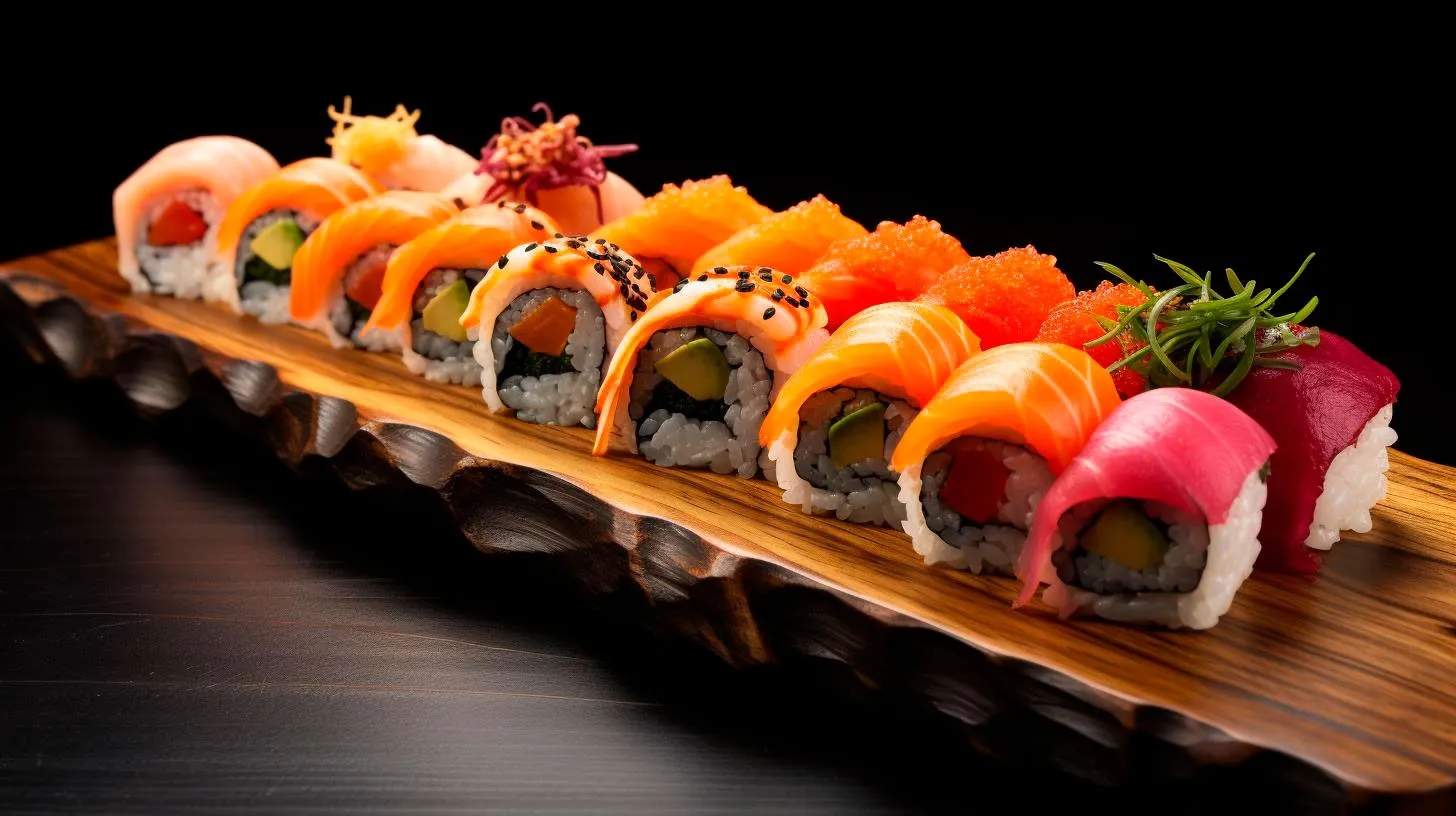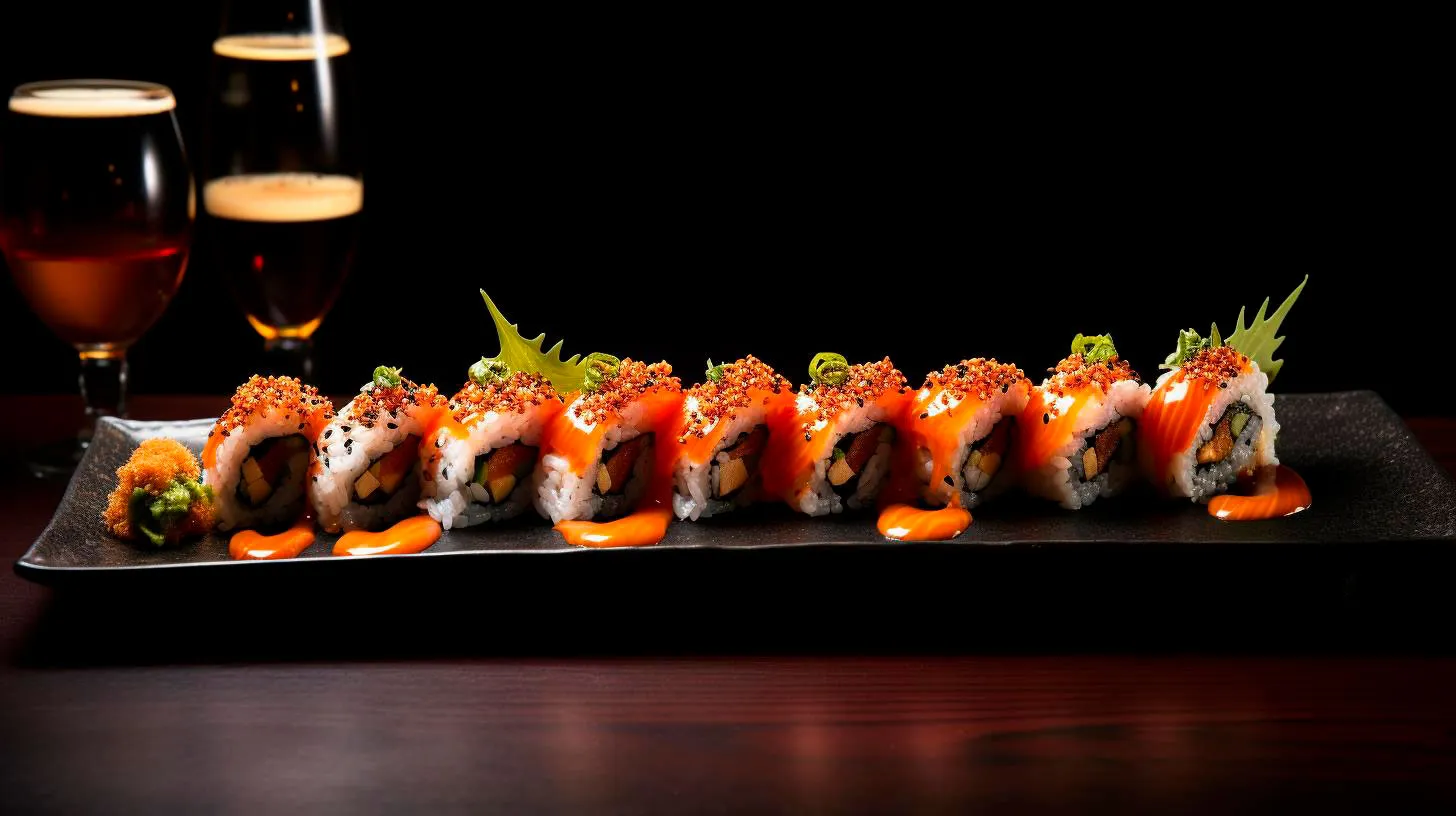Safe Handling and Storage of Sushi Ingredients
The Importance of Safe Handling and Storage
Before we dive into the details, let’s take a moment to understand why safe handling and storage of sushi ingredients are paramount. Properly handling and storing these perishable items is essential to maintain their freshness, prevent foodborne illnesses, and preserve their flavors. By following these guidelines, you can ensure that your sushi creations are both delicious and safe for all to enjoy.
Handling Sushi Ingredients
When it comes to handling sushi ingredients, there are a few key points to keep in mind:
- Hygiene is Key: Always wash your hands thoroughly before handling any sushi ingredients, as it helps prevent the transfer of bacteria or other contaminants.
- Use Fresh Ingredients: Ensure that all the ingredients used are fresh and of high quality. Freshness plays a critical role in the taste and safety of sushi.
- Separate Raw and Cooked Ingredients: It is crucial to keep raw ingredients separated from cooked ones to minimize the risk of cross-contamination.
- Follow Proper Thawing Techniques: If using frozen ingredients, follow the recommended thawing techniques to maintain the integrity of the ingredients while eliminating any harmful bacteria.
Storing Sushi Ingredients
Once you have handled the sushi ingredients, it’s equally important to store them properly to prevent spoilage and maintain their freshness. Here are some key tips for storing sushi ingredients:
- Utilize Refrigeration: Ensure that all sushi ingredients, especially seafood and other perishable items, are stored in a refrigerator at or below 40°F (4°C). This helps slow down bacterial growth.
- Keep Ingredients Separate: Store different types of ingredients separately to avoid cross-contamination and maintain their individual flavors.
- Rotate Stock: It’s important to follow the first-in, first-out (FIFO) principle by using older ingredients before newer ones. This prevents wastage and ensures the freshness of your sushi creations.
- Properly Label Containers: Labeling containers with the date of purchase or expiration helps you keep track of ingredient freshness and prevents confusion.
Key Takeaways
Safe handling and storage of sushi ingredients are essential to maintain their quality, taste, and most importantly, to ensure the safety of anyone consuming sushi dishes. Here are the key takeaways:
- Always prioritize hygiene by washing your hands thoroughly before handling sushi ingredients.
- Use fresh and high-quality ingredients to ensure the best taste and minimize potential risks.
- Separate raw and cooked ingredients to avoid cross-contamination.
- Follow proper thawing techniques for frozen ingredients.
- Store sushi ingredients in the refrigerator at or below 40°F (4°C) to slow down bacterial growth.
- Keep different ingredients separate to preserve their individual flavors.
- Follow the FIFO principle to avoid ingredient wastage and maintain freshness.
- Label containers with purchase or expiration dates to track ingredient freshness.
By following these guidelines, you can ensure the safe handling and storage of sushi ingredients while creating delightful and scrumptious sushi dishes.
Now that you’re equipped with these essential tips, go ahead and unleash your sushi-making prowess while keeping food safety at the forefront. Stay tuned for more exciting articles on our tech blog!
Separating Raw and Cooked Ingredients in Sushi Making
When it comes to sushi, maintaining the distinction between raw and cooked ingredients is not only important for taste and presentation but also plays a significant role in food safety. Ensuring the separation of raw and cooked elements helps to prevent cross-contamination and the potential spread of bacteria or parasites.
The Importance of Separation
Raw fish, such as salmon, tuna, and mackerel, is a staple in many sushi rolls and nigiri. These fish are often consumed raw or lightly cooked, which adds a unique flavor profile to sushi. On the other hand, cooked ingredients like shrimp, eel, and octopus undergo specific cooking techniques before being added to sushi preparations.
By separating raw and cooked ingredients, sushi chefs address several essential factors:
- Food Safety: Raw fish can carry harmful bacteria, parasites, or viruses. Proper separation prevents cross-contamination and reduces the risk of foodborne illnesses.
- Flavor and Texture: Separation of ingredients ensures that the distinct flavors and textures of raw and cooked components remain intact, enhancing the overall taste experience for sushi lovers.
- Visual Presentation: Separating raw and cooked ingredients adds aesthetic appeal to sushi rolls, allowing diners to visually differentiate between various ingredients.
Key Techniques for Separation
Sushi chefs employ various techniques to maintain the segregation of raw and cooked ingredients:
1. Dedicated Preparation Areas
Professional sushi kitchens often have designated areas for handling raw and cooked ingredients. This spatial separation minimizes the risk of cross-contamination and ensures a hygienic cooking environment.
2. Separate Utensils
Using distinct utensils for handling raw and cooked elements is critical to maintain separation. Chefs employ different knives, cutting boards, and containers to avoid any mixing or transfer of bacteria between ingredients.
3. Proper Storage
Raw and cooked ingredients must be stored separately to prevent any potential contact. Refrigerated or frozen storage units are utilized to maintain ingredient freshness while minimizing the possibility of cross-contamination.
4. Color-Coded Platforms
In some sushi restaurants, color-coded platforms are used to distinguish between raw and cooked ingredients. This visual cue serves as a helpful reminder for chefs and assists in maintaining proper separation while preparing sushi rolls.
Advantages and Takeaways
The benefits of separating raw and cooked ingredients in sushi making cannot be overstated. Here are some key advantages and takeaways:
- Food Safety: Proper separation reduces the risk of foodborne illnesses caused by cross-contamination.
- Enhanced Flavor: Separation ensures that the distinct flavors of raw and cooked ingredients are preserved, delivering a delightful culinary experience.
- Improved Presentation: The separation of raw and cooked elements adds visual appeal to sushi rolls, enticing diners with their vibrant colors and textures.
- Hygienic Standards: Implementing dedicated preparation areas and separate utensils promotes high hygiene standards in sushi kitchens.
- Customer Satisfaction: By upholding the principles of separation, sushi chefs instill confidence in their patrons regarding the quality and safety of their sushi creations.
Next time you enjoy a sushi dining experience, take a moment to appreciate the artistry behind the separation of raw and cooked ingredients. This intricate process sets the stage for mouthwatering flavors, impeccable presentation, and a safe sushi indulgence.
Sanitizing Utensils and Surfaces in Sushi Preparation
The Importance of Sanitizing Utensils and Surfaces
1. Preventing Food Contamination: Sushi ingredients, such as raw fish, are highly perishable and can harbor harmful bacteria and parasites. By thoroughly sanitizing utensils and surfaces, we can eliminate these contaminants and minimize the risk of foodborne illnesses.
2. Ensuring Taste and Quality: Proper sanitization practices not only contribute to food safety but also help maintain the taste and quality of the sushi. Contaminated utensils or surfaces can alter the flavors and aromas of the ingredients, compromising the overall dining experience.
3. Meeting Health Regulations: Health departments across the globe have established strict guidelines for food establishments, and proper sanitization is a key requirement. Adhering to these regulations not only avoids penalties but also demonstrates a commitment to customer welfare.
Best Practices for Sanitizing Utensils and Surfaces
1. Use Hot Water and Dish Soap
Start the sanitization process by washing utensils and surfaces with hot water and dish soap. This step helps to remove visible dirt, grease, and impurities. Thoroughly rinse off the soap to ensure no traces are left behind.
2. Utilize Heat to Kill Bacteria
Heat is an effective tool to eliminate bacteria and other pathogens. After washing, submerge utensils in boiling water for a few minutes or use a commercial dishwasher that reaches high temperatures. For surfaces, steam cleaning can be a great option, ensuring the eradication of potential contaminants.
3. Implement Sanitizing Solutions
Utilize approved sanitizing solutions to further disinfect utensils and surfaces. These solutions are typically mixed with water, following the manufacturer’s instructions. Immerse utensils in the solution for the recommended time, ensuring complete coverage. Surfaces can be wiped down with sanitizing solution using a clean cloth.
4. Regularly Replace Sponges and Towels
Sponges and towels can accumulate bacteria over time, making them potential sources of contamination. Regularly replace them or sanitize them using bleach or hot water to prevent cross-contamination.
5. Consider UV Sterilization
Innovative technologies such as UV sterilization can be employed to further enhance the sanitization process. UV light effectively kills bacteria and viruses, offering an additional layer of protection for utensils and surfaces.
Key Takeaways
Ensuring the utmost hygiene in sushi preparation is of utmost importance. Proper sanitization of utensils and surfaces is vital for preventing food contamination, maintaining taste and quality, and complying with health regulations. Remember these key takeaways:
- Sanitizing utensils and surfaces prevents food contamination and reduces the risk of foodborne illnesses.
- Using hot water and dish soap, implementing heat, and utilizing sanitizing solutions are effective methods to sanitize utensils and surfaces.
- Regularly replacing sponges and towels and considering UV sterilization can further enhance the sanitization process.
By following these best practices and prioritizing proper sanitization, sushi chefs and establishments can provide their customers with a safe and enjoyable dining experience, free from the worries of foodborne illnesses.
Proper Handwashing Techniques for Sushi Chefs
In this article, we will explore the correct handwashing methods that sushi chefs should follow to ensure the safety and quality of the sushi they prepare.
The Importance of Handwashing
Handwashing is a fundamental practice in the food service industry and plays a crucial role in preventing the spread of germs and bacteria. According to the Centers for Disease Control and Prevention (CDC), handwashing can reduce the risk of diarrheal illness by up to 31%. When it comes to sushi preparation, proper hand hygiene becomes even more critical as it involves handling raw fish and other ingredients that may be contaminated.
For sushi chefs, maintaining the highest hygiene standards is not only important for the safety of customers but also for the reputation of their establishments. By following the correct handwashing techniques, chefs can reduce the risk of cross-contamination and foodborne illnesses, ensuring a safe dining experience for everyone.
Proper Handwashing Techniques for Sushi Chefs
To ensure effective handwashing, sushi chefs should follow these steps:
- Wet your hands: Start by wetting your hands with clean, running water. The temperature of the water should be comfortable to touch.
- Apply soap: Apply enough soap to cover all surfaces of your hands. This can help to remove germs and bacteria more effectively.
- Scrub your hands: Rub your hands together vigorously for at least 20 seconds. Pay attention to all areas, including fingers, palms, backs of hands, and wrists. Proper scrubbing ensures the removal of dirt and harmful microbes.
- Rinse thoroughly: Rinse your hands under clean, running water, removing all soap residue along with the germs and bacteria.
- Dry your hands: Dry your hands using a clean paper towel or air dryer. Avoid using a shared towel as it may harbor germs.
- Use hand sanitizer: While handwashing is the preferred method, using an alcohol-based hand sanitizer with at least 60% alcohol content can be an additional step to ensure hygiene. Apply the sanitizer on the palm of one hand and rub it all over the surfaces of both hands until dry.
Key Takeaways
Here are a few key takeaways to remember regarding proper handwashing techniques for sushi chefs:
- Handwashing is crucial in maintaining hygiene and preventing the spread of foodborne illnesses.
- Sushi chefs should wash their hands before handling food, especially raw fish and other ingredients.
- Handwashing should be done using clean, running water and soap.
- Scrubbing hands for at least 20 seconds ensures the removal of dirt and microbes.
- Hand sanitizers can be used as an additional precaution.
By following these proper handwashing techniques, sushi chefs can ensure the safety and quality of the sushi they prepare. Customers can dine with confidence, knowing that their meal has been prepared with the utmost care and hygiene.


